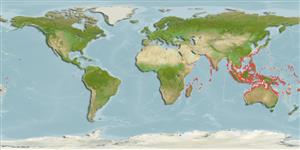>
Mulliformes (Goatfishes) >
Mullidae (Goatfishes)
Etymology: Parupeneus: Latin, parum, parvum = small + Peneus, the name of a river.
More on author: Shaw.
Environment: milieu / climate zone / depth range / distribution range
Écologie
marin; saumâtre récifal; profondeur 10 - 30 m (Ref. 48636). Tropical; 19°N - 23°S, 28°E - 150°W
Indo-Pacific: Yemen coast of the Gulf of Aden and southern Oman, along the east coast of Africa to Port Alfred, South Africa (33°S), east to the Caroline and Somoan islands; southern Japan to southern Queensland.
Taille / Poids / Âge
Maturity: Lm ? range ? - ? cm
Max length : 45.0 cm TL mâle / non sexé; (Ref. 48636); common length : 35.0 cm TL mâle / non sexé; (Ref. 48636)
Épines dorsales (Total) : 8; Rayons mous dorsaux (Total) : 9; Épines anales: 1; Rayons mous anaux: 7. Diagnosis: Pectoral rays 16 (rarely 15 or 17). Gill rakers 5-7 + 18-21 (total 24-27)> Body depth 3.25-3.75 in SL; head length (HL) 2.9-3.25 in SL; snout length 1.65-1.95 in HL; barbel length 1.3-1.5 in HL. Longest dorsal spine 1.5-1.8 in HL; penultimate dorsal ray about equal to last dorsal ray in juveniles, 1.05-1.2 in length of last dorsal ray of adults; pectoral-fin length 1.35-1.55 in HL; pelvic-fin length 1.3-1.5 in HL. Body greenish brown to reddish brown dorsally, the scale edges narrowly dark, shading to whitish or pale pink ventrally, with a nearly round black spot as large or larger than eye on side of caudal peduncle, two-thirds of which lies above the lateral line; a large, horizontally elongate yellow spot (sometimes partly white) on lateral line below interdorsal space; barbels white; irregular pale blue lines extending anteroventrally and dorsoposteriorly from eye; second dorsal and anal fins with irregular oblique pale blue lines; caudal fin yellowish gray with faint blue lines paralleling rays; peritoneum dark brown (pale brown to white in other species of the genus except Parupeneus barberinus) (Ref. 54393).
Inhabit shallow sandy or silty areas (seagrass substrata) of coastal and inner lagoon reefs (Ref. 9710, 54393). Occur singly or in schools (Ref. 5213). Large adults usually at moderate depths to about 30 m (Ref. 48636). Feed on benthic invertebrates; the diet including small crabs, amphipods, shrimps, small octopuses, polychaete worms, and small fishes (Ref. 54393). Marketed fresh (Ref. 5284).
Life cycle and mating behavior
Maturities | Reproduction | Spawnings | Egg(s) | Fecundities | Larves
Randall, J.E., 2004. Revision of the goatfish genus Parupeneus (Perciformes: Mullidae), with descriptions of two new species. Indo-Pac. Fish. (36):64 p. (Ref. 54393)
Statut dans la liste rouge de l'IUCN (Ref. 130435)
Menace pour l'homme
Harmless
Utilisations par l'homme
Pêcheries: commercial; pêche sportive: oui
Outils
Articles particuliers
Télécharger en XML
Sources Internet
Estimates based on models
Preferred temperature (Ref.
123201): 26.2 - 29, mean 28.2 °C (based on 442 cells).
Phylogenetic diversity index (Ref.
82804): PD
50 = 0.5000 [Uniqueness, from 0.5 = low to 2.0 = high].
Bayesian length-weight: a=0.01175 (0.00956 - 0.01444), b=3.10 (3.07 - 3.13), in cm total length, based on LWR estimates for this species (Ref.
93245).
Niveau trophique (Ref.
69278): 3.5 ±0.37 se; based on food items.
Résilience (Ref.
120179): Milieu, temps minimum de doublement de population : 1,4 à 4,4 années (Preliminary K or Fecundity.).
Prior r = 0.67, 95% CL = 0.44 - 1.01, Based on 2 data-limited stock assessments.
Fishing Vulnerability (Ref.
59153): Low to moderate vulnerability (35 of 100).
Nutrients (Ref.
124155): Calcium = 29.3 [14.0, 66.8] mg/100g; Iron = 0.276 [0.137, 0.641] mg/100g; Protein = 18.2 [14.9, 21.2] %; Omega3 = 0.12 [0.07, 0.23] g/100g; Selenium = 44.7 [21.2, 118.3] μg/100g; VitaminA = 178 [31, 850] μg/100g; Zinc = 0.611 [0.357, 1.147] mg/100g (wet weight); based on
nutrient studies.
